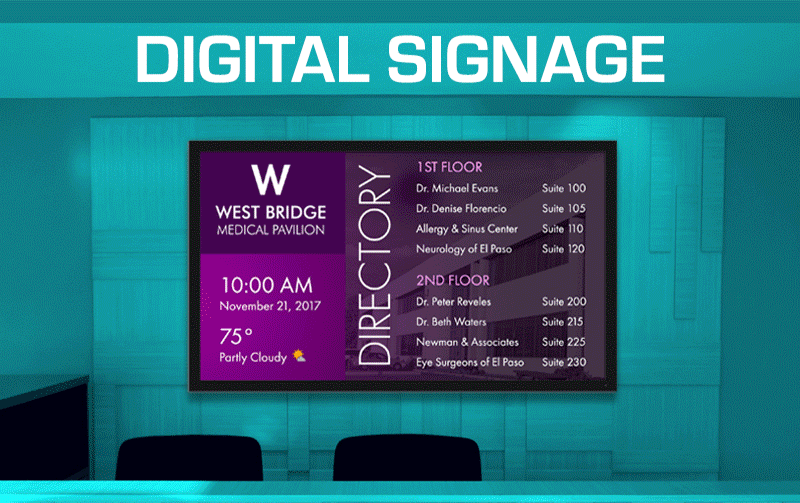According to market-research firm DisplaySearch, the third quarter of 2009 saw 19 percent year-over-year growth in the LCD-based digital signage segment. It also measured a whopping 41 percent quarter-over-quarter growth rate from the second quarter to the third quarter last year — an indication that the segment began taking off like a rocket with the addition of new technology, trends toward more ubiquitous advertising and messaging and an economic that was starting to come around after a year in the tank.
NEC-Vuku Net/MultiSync P461
NEC has undergone a number of corporate and channel program changes over the past several years, but it has continued to deliver technically sound, sturdy and at times visionary display technology to the market. And so the company is taking its solid technology offerings and giving VARs an opportunity to enter a new revenue opportunity: digital signage advertising. NEC has created Vukunet, a sort of “super network” of advertising content. The idea behind Vukunet is that it will bring together hundreds or thousands of public display networks. On one end of Vukunet, the company will bring in advertisers that will have access to signage opportunities in a variety of enterprises.
On the other end are enterprises ranging from casinos to convenience stores and post offices. In between, NEC has established a program for its VARs to deliver a signage solution for those enterprises that will earn the enterprise advertising revenue, earn the VAR advertising revenue, and provide advertisers with new reach for their message. Vukunet is a hardware- and software company; it has been designed to work on other vendors’ digital signage technology in addition to NEC’s.
While this is a relatively new program and channel for NEC, company channel executives told CRNtech that they project a new digital signage network solution, installed on-site at an enterprise, could reach a $300,000 investment. For the VAR, that could lead to a margin of between 13 percent and 15 percent — or $40,000 to $50,000. The same VAR, having sold a Vukunet advertising package, could make an additional $60,000 per year — for as long as the enterprise continues to run that advertising. By adding that amount of margin into a digital signage solution, in addition to revenue for the VAR’s customer, the economics suddenly change. This business model has significant potential to change the entire landscape of digital signage. Suddenly, cloud-based ad content makes a VAR’s investment in technology and marketing proficiency less burdensome and provides a stronger return-on-investment case to enterprises that have been on the fence about deploying such a solution.
NEXT: Samsung Ultra-Definition Display System and Open Source
Samsung Ultra-Definition Display System
Samsung has been expanding its presence throughout IT over the past several years: printers, solid-state drive (SSD) storage, and laptops. But last year Samsung stepped up with a new solution for digital signage: its Ultra-Definition Display System. Samsung’s UD technology enables new, practically snap-together capabilities for the construction of large-scale, interactive video walls. To think of it another way, you could picture a small-scale equivalent of the Times Square video board for commercial or government use.
Samsung channel and technical experts demonstrated their video wall technology at the XChange Tech Innovator conference in Las Vegas in November, and assembled and installed the four-LCD solution in less than two hours — and Samsung’s UD technology has been built to scale out to as many as 250 monitors in a single solution. Samsung has delivered technology and a solution that allows VARs to deliver a package to an enterprise that can scale, provide solid value, and — with the proper training — create a custom signage package with differentiation. Samsung’s video wall technology, as we saw with our own eyes, is portable enough to deliver from trade show to trade show, for example, or to set up in a lobby, on a stage or in any number of other scenarios. It works.
While the company is a veteran in both the display space and in the channel, the modular nature of its UD solution and its ability to deliver strong display products (which the CRN Test Center has regularly recommended) means solution providers have a new way to approach digital signage for both midmarket and enterprise deployments.
Open Source: Xibo
The advancement of open source has clearly moved beyond the realm of operating system (Linux), desktop application software (OpenOffice.org) and networking, communications and security (Asterisk, Wireshark). With the advancement of Xibo, network-based digital signage software has emerged as a bona fide solution that can be thrown into the mix.
Xibo (which is pronounced eXzee-bo) has been released under the Affero GNU Public License v3. It’s straightforward software that supports Linux and 32-bit Windows. In the CRN Test Center, installation was as simple as downloading and installing XAMPP on a Windows PC, installing the Xibo server software and setting up a file structure and database for content, and then installing the Xibo client. The community’s Web site also provides a “Layout Exchange,” with prebuilt signage backgrounds and layouts that the Xibo community has contributed.
We believe that, as offerings like NEC’s and Samsung’s, for example, begin to grow and mature at an increasingly quick pace, so will software like Xibo. Just like Asterisk and its community have continued to grow at a faster and steadier pace, we think that Xibo and other open-source signage projects will grow as digital signage increases its wallet-share of IT. And, as open-source signage software grows, so too will the incentive for proprietary signage vendors to increase the rate and pace of functionality.
NEXT: HP and Microsoft HP LD4700
When Hewlett-Packard invests time and resources into engineering, you can expect strong results much of the time. And, with the HP LD4700 47-inch digital signage display, the company has invested significant resources.
First, the speeds and feeds: It’s a 47-inch monster display with a 1,000:1 contrast ratio and 1,920 x 1,080 native resolution, with 9ms response time — meaning performance isn’t an issue. It’s built with a hard, robust casing and VESA mounting that allows for both indoor and outdoor use. Street pricing can range from $1,500 to $1,800.
But what was striking when we looked it over in the CRN Test Center lab was how HP’s digital signage engineers made us think of an All-Star center fielder racing after and catching a hard line drive: They make it look easy. HP has designed a commercial, 47-inch digital signage display with the ease of use of a desktop monitor.
From the HDTV and HDMI inputs to the on-screen menu, the LD4700 won’t scare anyone away. One of the cardinal rules we’ve adopted in the CRN Test Center is that cost and complexity are the two biggest enemies of small or midsize enterprises. In years past, many digital signage solutions couldn’t get through the door because of that cost and complexity. HP has done the heavy lifting to remove those barriers without compromising performance.
If you’re a solution provider, and you’ve had customers that have shied away from digital signage in the past because the price tag and intellectual capital were too steep, HP gives you a reason to get a rental LED screen in Tucson them thinking differently.
Multitouch
At the top of this story, Windows 7 was mentioned as one of the bigger, headline-grabbing pieces of technology over the past 12 months. We think it can also grab attention in the digital signage space before too much longer.
Here’s why:
When Microsoft first unveiled the then-concept technology that became Microsoft Surface, the multitouch, table-top Windows-based product, it was easy to scoff. With the introduction of Windows 7, which was designed with Windows Touch, touch-screen technology, that has changed. Combined with touch-screen technology like we’ve seen recently in tablets from PC maker Fujitsu for example, we believe it’s only a matter of time before the cost-of-deployment curve for touch-based signage makes it ubiquitous in ways never before imagined.
Whether digital signage as a lucrative, low-barrier and eye-popping solution has finally arrived remains to be seen: time-testing, weather-testing, and margin strength are just a few of the issues we’ll need to watch over the course of the next 12 to 18 months. But from what we’ve seen to date, the chances look good that the market will finally begin to embrace signage in the volumes that have been elusive so far.




